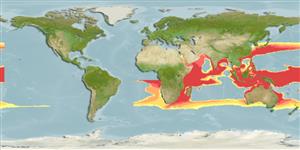Environment: milieu / climate zone / depth range / distribution range
Ecología
marino; rango de profundidad 0 - 50 m (Ref. 106604). Tropical
Indo-West Pacific: eastern coast of Africa to Indonesia.
Length at first maturity / Tamaño / Peso / Age
Maturity: Lm ?, range 115 - ? cm
Max length : 119 cm WD macho / no sexado; (Ref. 11441); 120.0 cm WD (female); peso máximo publicado: 30.0 kg (Ref. 11228)
Short description
Morfología | Morfometría
A small devilray with a short head bearing short head fins; dorsal fin white-tipped, and pectoral fins with slightly curved tips; upper surface with no denticles and tail shorter than disc, with no spine (Ref. 5578). Dark brown above, white below (Ref. 5578).
Found in coastal and oceanic waters (Ref. 5578). Feeds on plankton (Ref. 30573). Ovoviviparous (Ref. 50449). Generally found in schools, leaping out of the water (Ref. 11228). Caught rarely in the tuna gillnet fisheries. Utilized for its gill filter plates (high value), meat, cartilage and skin (Ref.58048).
Life cycle and mating behavior
Madurez | Reproducción | Puesta | Huevos | Fecundidad | Larva
Exhibit ovoviparity (aplacental viviparity), with embryos feeding initially on yolk, then receiving additional nourishment from the mother by indirect absorption of uterine fluid enriched with mucus, fat or protein through specialised structures (Ref. 50449). Probably giving birth to only one pup; born at ~31 cm WD (Ref.58048).
Randall, J.E., 1995. Coastal fishes of Oman. University of Hawaii Press, Honolulu, Hawaii. 439 p. (Ref. 11441)
IUCN Red List Status (Ref. 130435)
Threat to humans
Harmless
Human uses
Pesquerías: escaso valor comercial
Más información
Age/SizeCrecimientoLength-weightLength-lengthLength-frequenciesMorfometríaMorfologíaLarvaDinámica larvariaReclutamientoAbundanciaBRUVS
ReferenciasAcuiculturaPerfil de acuiculturaRazasGenéticaElectrophoresesheritabilidadEnfermedadesProcesamientoNutrientsMass conversion
ColaboradoresImágenesStamps, Coins Misc.SonidosCiguateraVelocidadTipo de nataciónSuperficie branquialOtolitosCerebrosVisión
Herramientas
Special reports
Download XML
Fuentes de Internet
Estimates based on models
Preferred temperature (Ref.
123201): 23.9 - 29.1, mean 28 °C (based on 1852 cells).
Phylogenetic diversity index (Ref.
82804): PD
50 = 0.5005 [Uniqueness, from 0.5 = low to 2.0 = high].
Bayesian length-weight: a=0.01000 (0.00244 - 0.04107), b=3.04 (2.81 - 3.27), in cm total length, based on all LWR estimates for this body shape (Ref.
93245).
Nivel trófico (Ref.
69278): 3.4 ±0.45 se; based on food items.
Resiliencia (Ref.
120179): Bajo, población duplicada en un tiempo mínimo de 4.5-14 años (Fec assumed to be <100).
Fishing Vulnerability (Ref.
59153): Very high vulnerability (85 of 100).
